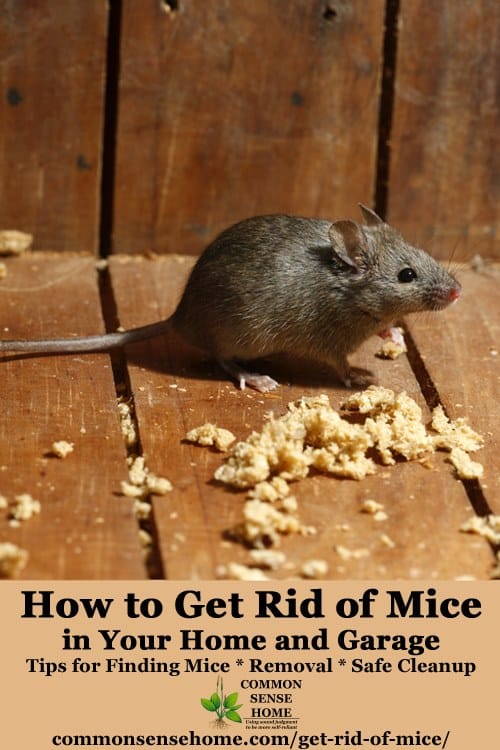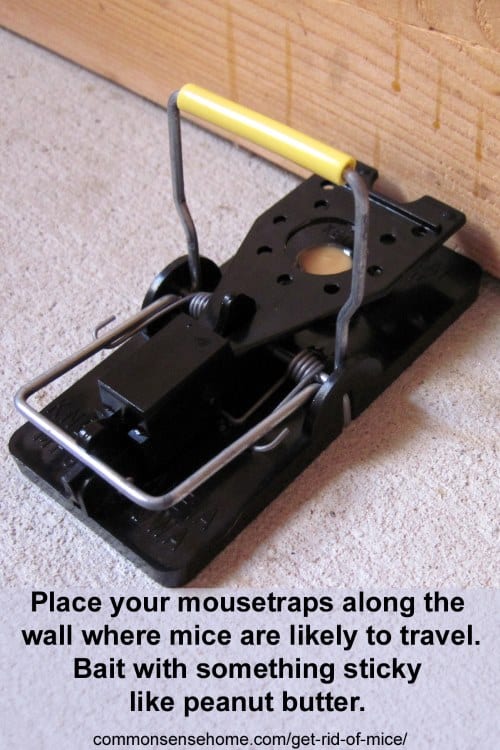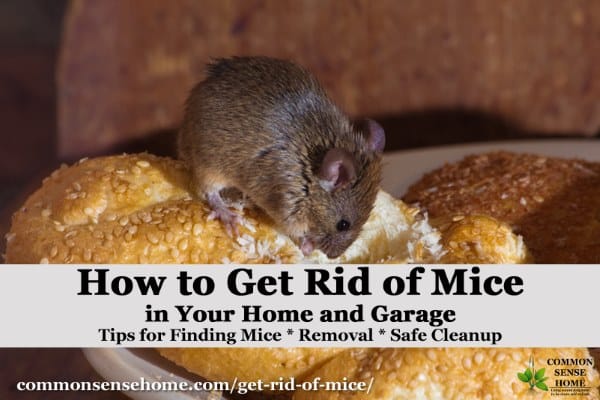How to Get Rid of Mouse Urine Smell in Garage
This post may contain affiliate links which won't change your price but will share some commission.

If you build it, mice will come. Sooner or later, you'll probably need to get rid of mice or rats. Fall is prime time for an increase in mice in your house, as they look for winter protection, but mice and rats can move in at any time.
While small, mice and rats can cause big problems. They chew on everything, causing property damage and potential fire risks when they gnaw on electrical wiring and build tinder dry nests in dark corners.
Rodents can spread disease, on their own, through the parasites they carry (their fleas carried the Black Plague) or through their droppings (such as hantavirus).

Contents
- How to Tell if You Have Mice in Your House
- Identifying Droppings and Urine
- Rodent (Mice and Rat) Droppings
- Rodent Urine
- Rodent Food and Nests
- How to Keep Mice Out of Your House and Garage
- 1. Remove Food Sources
- 2. Seal Openings
- 3. Reduce Outside Habitat
- 4. Set up Barricades with Kitty Litter and Peppermint Essential Oil
- Best Ways to Get Rid of Mice that Are Already in Your Home
- Poisons
- Traps
- Bucket Mouse Trap
- How to Safely Clean Up Mice and Mouse Droppings
How to Tell if You Have Mice in Your House
It's probably more common to see mouse droppings or mouse damage before you see the mice themselves, as they are nocturnal.
When I was a kid, the little buggers would drive me crazy at night running around up in the attic. Thankfully we didn't get rats in the house, but they would sometimes show up in the outbuildings around the farm.
Identifying Droppings and Urine
Killum Pest Control offers an excellent online guide to interpreting rodent signs. Please visit their site for more information, but I'll just share briefly their comments on dropping and urine identification.
Rodent (Mice and Rat) Droppings
Fresh droppings of feces usually are moist, soft, shiny and dark, but in a few days they become dry and hard. Old droppings are dull and grayish and crumble when pressed with a stick.
The roof rat's droppings are up to 1/2 inch long, spindle shaped and curved in contrast to Norway rat droppings which are about the same length but comparatively blunt. Mouse feces are small, averaging about 1/8 inch long, and are pointed on both ends.
Rodent Urine
Dried rodent urine will fluoresce bluish white to yellowish white. Commercial black lights often are used to detect rodent urine, however observing fluorescence is not a guarantee that rodent urine is present.
Numerous items will fluoresce under a black light, including optical bleaches found in many detergents and lubricating oil. Of course, if there's a glowing track of pee, odds are you have mouse movement.
Mice commonly mark their trails with urine (yes, I know, you probably didn't really want to know that…) so that other mice can follow their tracks to food sources.
One source I read said that they produce 50-60 droppings per night – ewwww…
Once you've found their way into your home, you need to block it, otherwise they be right back in via the pee track highway. They can climb, too – like mini rodent ninjas.
Rodent Food and Nests
You may also find food stashes and nests in out of the way corners. I remember finding a mouse nest in the back of an old school desk in my room.
Gnawing damage is another dead giveaway. My mom had a cardboard box of old cooking magazines inside a wooden cabinet, and the mini rodent ninjas still found their way in and chewed the edges of the magazines.
How to Keep Mice Out of Your House and Garage
To keep these critters out and keep your family safe and your goods protected, follow these simple steps.
1. Remove Food Sources
Bird food, pet food and other edible odds and ends (even cardboard) that tend to pile up in garages are like mouse nirvana. Crumbs under the couch are a gourmet treat, and a cookie lost by toddler is a mouse family buffet.
Seal all food (for pets or humans) in solid containers, not just in bags. (Rats can and will chew through plastic bins, so be warned. You need to use metal containers to keep rats out.) Plastic garbage cans or Rubbermaid tubs will generally keep mice out.
Clean, clean, clean! Gaps between appliances like stoves or refrigerators and cabinets can collect crumbs where they are difficult for you to clean, but handy for mice to dine.
Remember, if they can get their heads into a space, their bodies can get in, too.
2. Seal Openings
This is the probably the toughest but most effective way to keep mice out – seal openings.
As I mentioned above, if a mouse can get its head though, the body can go through as well. The little pests only need about a ¼ inch (0.6 cm) wide opening.
They can jump – up to 18 inches (I told you – mini rodent ninjas), travel upside down (you bet), and crawl along an electrical wire (piece of cake). If you can stick a #2 pencil through a hole, a mouse can probably use it to get into your home.
When you find holes, you want to try and seal them as strongly as possible.
The Internet Center for Wildlife Damage Management recommends: Steel wool, copper gauze (stuff-fit) or screen wire packed tightly into openings is a good temporary plug.
For long-term or permanent repair, mix a quick-drying patching plaster or anchoring such as Fixall® into a wad of Stuf-it® before pushing the material into the hole, and smooth over the outside.
If steel wool is used, rust stains are likely to result. Holes 3 inches (8 cm) or more in diameter should be covered or backed with 1/4-inch (0.6-cm) woven/welded hardware cloth prior to filling with a good patching compound.
One of our readers has also had good results with GREAT STUFF Pestblock 12 oz Insulating Foam Sealant. They specifically include a bitter ingredient to make the foam unappetizing to pests.
3. Reduce Outside Habitat
If possible, reduce the amount of mouse habitat outside your home to reduce the number of mice inside your home.
Trim trees and shrubs away from the home. Clean up debris, brush piles, and other hiding spots where mice may take cover. Keep your compost bin(s) as tidy as possible (opossums and rats like to raid the compost, too).
I saw one site recommend moving wood piles 100 feet from the house and raising them one foot off the ground. Obviously they don't live in Wisconsin. The mice will have to stay in the wood pile – their nests make great tinder.
4. Set up Barricades with Kitty Litter and Peppermint Essential Oil
One of our readers shared her experience:
I used peppermint oil dropped on plain kitty litter. I put a small bag of litter (5lbs.) in a container from dollar store added 4 oz. Peppermint oil. Put lid on and shook it well. I left it over night.
Then I put about a tablespoon of the litter in a small piece of old sheet or cloth whatever you have lying around. tie it into a little bundle or sachet.
Place these around your house outside about every 2 feet and in garage and basement areas along walls. Lasts longer than spraying the oil and you don't have to worry about woodwork.
Remember mice have a keen sense of smell, after all they can find a lost potato chip behind a cabinet. So even though the smell decreases it's still working.
All I do is add a fresh drop of the peppermint oil to each little sachet every 6-12 months. Its been over two years since my mice disaster so it is working well for me.
Click here to buy 4 ounces of peppermint essential oil.
Best Ways to Get Rid of Mice that Are Already in Your Home
Your three main options are cats, traps and poison. I've come to love my kitties, but it's not practical for everyone to have a cat or cats in the house, and not all cats are good mousers. (I've had friends tell me about their cats who watch the mice run right past them.)
Poisons
Poisons do kill mice, but not immediately. The mice will crawl off and die somewhere and potentially smell really nasty, plus who wants mummified mice sitting around their house?
Poisons can also be a danger to children, pets, and wildlife that eats rodents. By using poison in an attempt to get rid of mice, you may make the problem worse. I don't recommend them.
Traps
Basic wooden mouse traps are cheap and readily available, but don't always work. A friend of mine was complaining recently that her mice kept stealing the bait but not getting caught in the trap.
I like Kness SNAP-E Mousetraps. They are much easier to set than the standard wooden traps. I used them to clear out the mice that moved into the garage last winter to go after the poultry feed. We tried a couple other brands, but the SNAP-Es worked the best to get rid of mice.
Humane traps are also available, but one site states that you need to take your mouse at least two miles away to make sure it will not return. I am not a mouse chauffeur, and I don't think it's right to share my mice with my neighbors.
My mom's favorite bait was peanut butter, which they can't grab and carry off. Others suggest tootsie rolls as another "stick tight" option. When you're placing traps, try to put them along walls where you believe mice are moving. Block their path with a buffet of your choosing instead of letting them into your cupboards.
Two traps side by side are better than one, as they will have a tougher time escaping both (remember – mini rodent ninjas). Set the traps perpendicular to the wall (see photo).
Check traps daily, empty and reset as needed. Odor from one mouse may help attract the next mouse, but having a deceased mouse hanging around doesn't do anyone any favors.

Bucket Mouse Trap
Another option that our readers brought to our attention is the Rolling Mouse Trap. It uses a bar, a bucket and peanut butter. The advantage is that it resets itself. The rolling trap can catch multiple mice per night.
This can be a live trap or filled partly with water to kill the mice. An alternate rolling trap is the PAWMATE Rolling Mouse Trap which has a wheel in the center for the peanut butter.
There are numerous YouTube videos on how to build your own if you are interested.
How to Safely Clean Up Mice and Mouse Droppings
Because of the risk of hantavirus and other illnesses, care should be taken when cleaning up mouse droppings/remains, especially in quantity and/or in enclosed areas. (Information adapted from Environment, Health and Safety Online.)
- Wear gloves, either rubber gloves or work gloves you can wash in hot water
- Spray the droppings first with 3% hydrogen peroxide, then with white vinegar. This will kill 99% of bacteria. A bleach water solution or disinfectant is also an option.
- Wipe up droppings with a paper towel, throw towel in garbage
- Clean area with disinfectant solution or hydrogen peroxide/vinegar combo
- Wash hands with soap and water before and after removing gloves
If dealing with large amounts of droppings, you may need professional help. At the very least, please wear a face mask or respirator. Please be careful! Your county extension office may be able to provide more information on any known rodent related disease outbreaks in your area.
Treat nesting materials and dead mice similarly. Always wash hands thoroughly after touching contaminated materials.
You may also find these other posts from our Green Home Series useful:
- How to Get Rid of Ants Naturally
- The Ultimate Guide to Natural Pest Control in the Garden
- Natural Mosquito Repellents That Work
- 9 Tips to Get Rid of Fruit Flies, Plus the Best Homemade Fruit Fly Trap
- Natural Spider Repellents – 8 Ways to Get Rid of Spiders

Originally posted in 2015, updated in 2021.
How to Get Rid of Mouse Urine Smell in Garage
Source: https://commonsensehome.com/get-rid-of-mice/